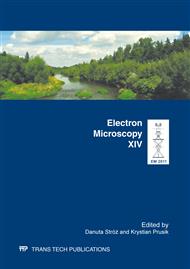p.45
p.49
p.53
p.58
p.62
p.66
p.70
p.74
p.78
High Resolution EBSD/SEM Analysis of PLZT Ferroelectric Crystals in Low Vacuum Conditions - A few Practical Remarks
Abstract:
Modern scanning electron microscopes (SEMs) increase the ability to study a wide range of materials. Especially, an application of low vacuum conditions enables characterization of nonconductive samples without complicated preparation procedure. However, the operator must be aware of several problems he may encounter collecting electron diffractions in the SEM with variable pressure. The charge control and quality of the surface are the challenges when running experiments on insulators. Specimen charging obscures forward scatter electrons images and decreases the EBSD pattern quality making indexing difficult or even impossible. Another crucial question is how to limit the influence of so called "skirt effect" caused by ionization of gas molecules followed by electron beam broading above the sample. The influence of several important parameters (gas pressure, a type of gas, working distance and energy of electron beam) on the EBSD pattern quality must also be considered. When it is properly done, a coupling of crystallographic information with the chemical data obtained from Energy Dispersive Spectroscopy (EDS) in the LV-SEM allows to perform phase identification of insulators. The paper presents some ideas how to deal with the (Pb, La)(Zr, Ti)O3 ceramics in high resolution Quanta 3D SEM (with thermally assisted Schottky type FEG) equipped with EDAX-TSL system in low vacuum environment. The problems occurring during EBSD analysis of the PLZT ceramics are discussed and some solutions are suggested. Paper summarizes the results obtained from PLZT ferroelectric ceramics in the low vacuum FEGSEM and shows how to optimise experimental parameters in order to achieve the best quality of orientation maps acquired from nonconductive samples.
Info:
Periodical:
Pages:
62-65
Citation:
Online since:
March 2012
Authors:
Keywords:
Price:
Сopyright:
© 2012 Trans Tech Publications Ltd. All Rights Reserved
Share:
Citation:


